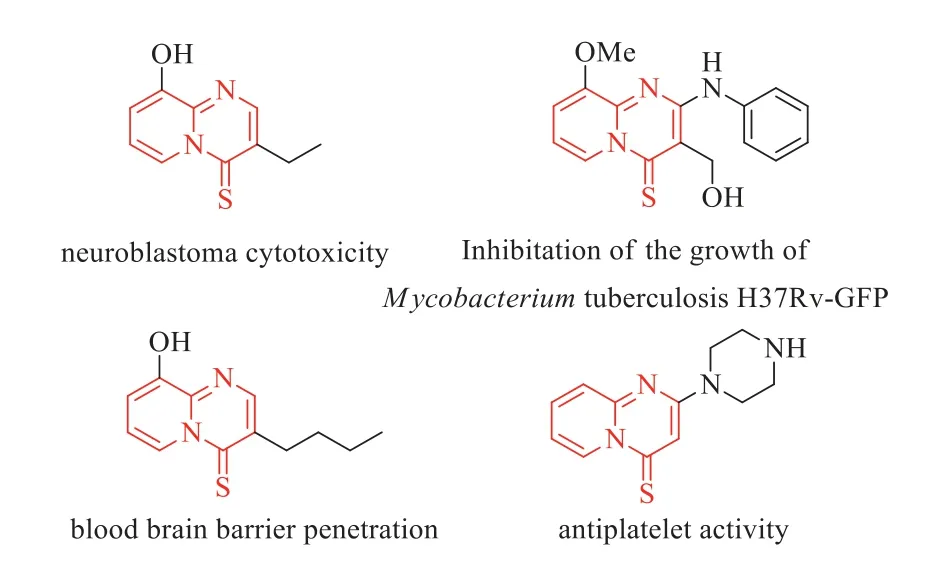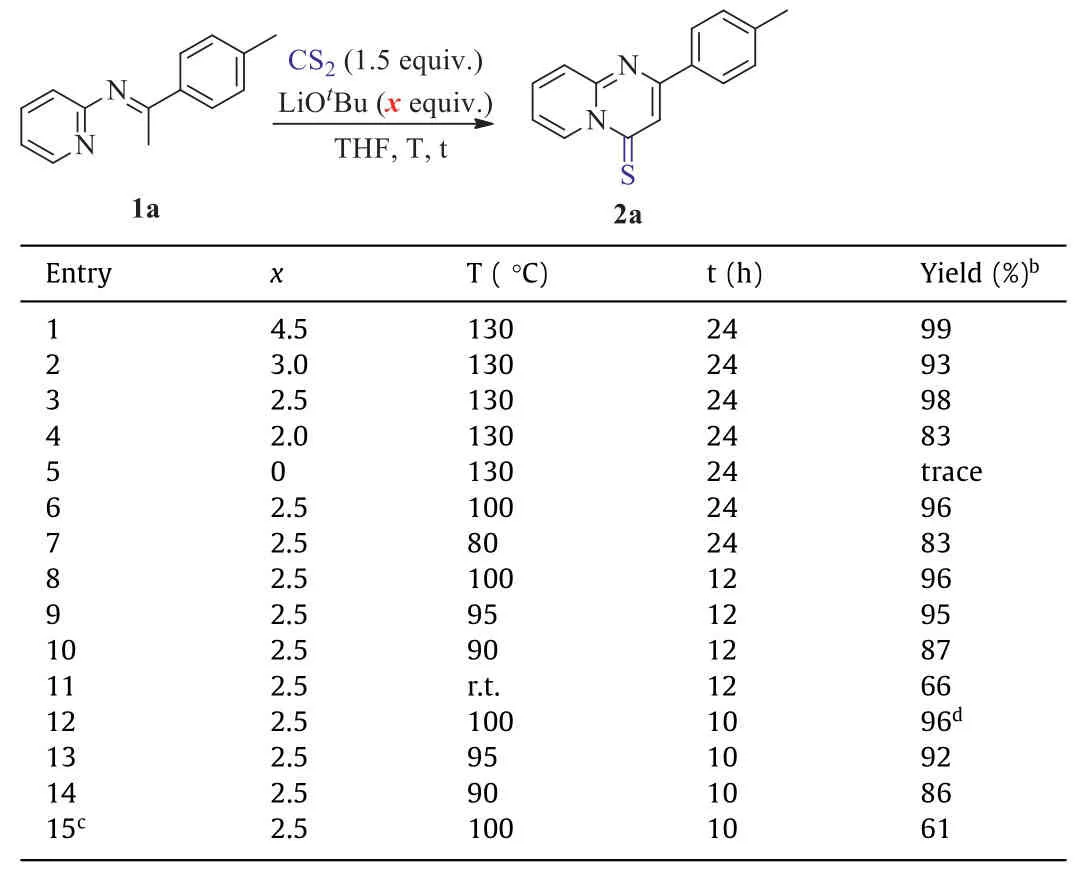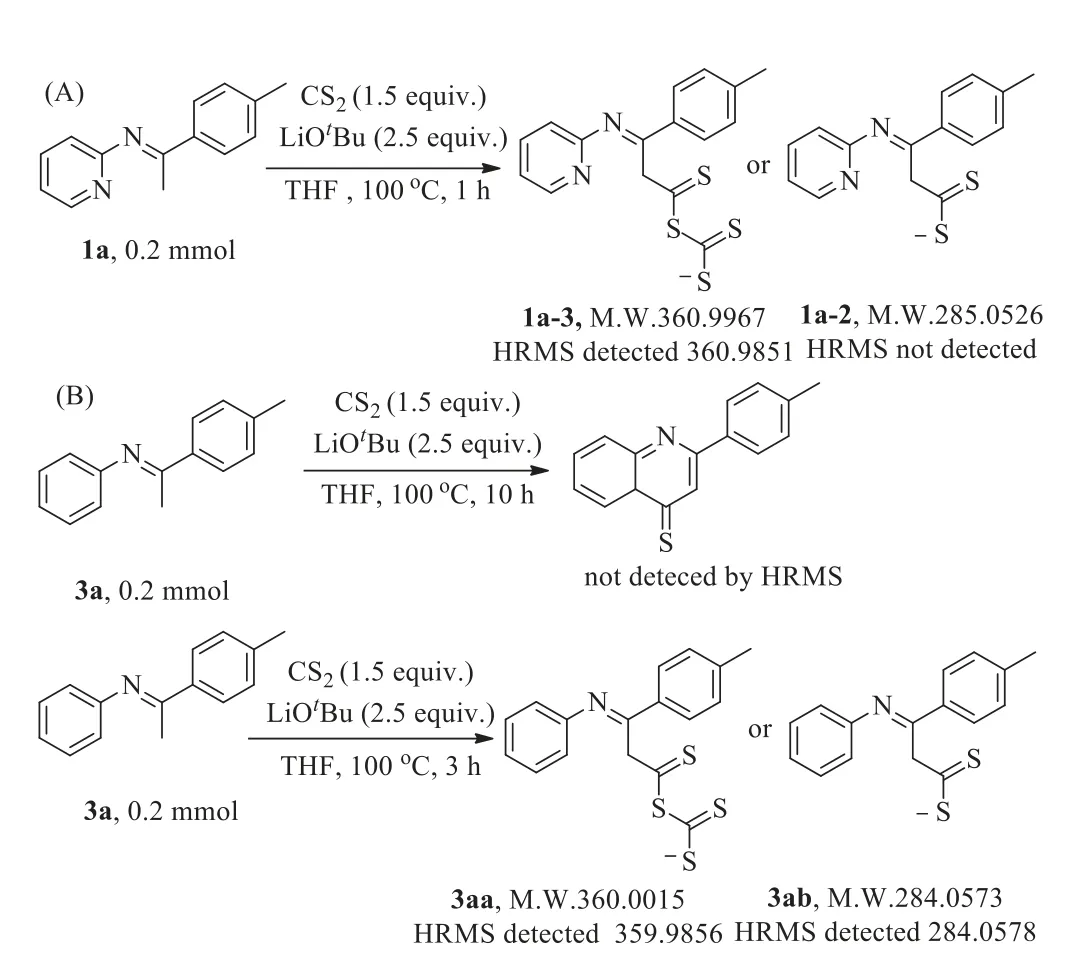Thiocarbonylation of C(sp3)-H bonds in pyridylamines with CS2:Facile synthesis of pyrido[1,2-a]pyrimidine-4-thiones
2021-03-14XioYuZhouXingYuLiZhenZhngGngYu
Xio-Yu Zhou,Xing-Yu Li,Zhen Zhng,b,∗,D-Gng Yu,∗
a Key Laboratory of Green Chemistry &Technology of Ministry of Education,College of Chemistry,Sichuan University,Chengdu 610064,China
b Key laboratory of Coarse Cereal Processing of Ministry of Agriculture and Rural Affairs,College of Food and Biological Engineering,Chengdu University,Chengdu 610106,China
Keywords:Pyridinylamines Thiocarbonylation Pyrido[1,2-a]pyrimidine-4-thiones Carbon disulfide Ketoimines
ABSTRACT Herein,a facile synthesis of valuable pyrido[1,2-a]pyrimidine-4-thiones is reported via novel thiocarbonylation of C(sp3)-H bonds with carbon disulfide (CS2).This reaction features easy availability of substrates,good functional group tolerance,high yields,facile scalability and atom economy.Mechanistic investigations indicate that sulfate anion and sulfuric anhydride anion might be involved in this reaction.
Construction of valuable thiocarbonyl-containing heterocycles has attracted much attention for long time due to their unique biological and pharmacological activities [1–3].Traditionally,they are usually synthesized by using elemental sulfur,Lawesson reagent,isothiocyanates and phosphorus pentasulfide as sulfur source [4–8].However,some drawbacks still exist for these sulfur sources,such as low atom-and step-economy,difficult-to-access substrates and/or low efficiency.Therefore,it is highly important to disclose an ideal thiocarbonyl source to synthesize valuable thiocarbonylcontaining heterocycles efficiently.Recently,metal sulfide species,such as potassium sulfide and sodium sulfide,have been used as sulfur source [9]to generate thiocarbonyl-containing compounds.However,in many cases,transition-metal catalysis (copper,ruthenium,etc.) is involved in the synthesis of sulfur-containing carbonyl heterocycles [10].Therefore,it is very attractive to find another ideal sulfur source to construct a thiocarbonyl heterocycles,especially through transition-metal-free process.In addition to a buck chemical and common solvent in industry,carbon disulfide(CS2) is also characterized as an ideal thiocarbonyl source due to the low cost,ready availability,stability and excellent solubility in organic solvent.In the past few decades,however,only few reports have documented CS2as a thiocarbonyl source to generate biologically active thiocarbonyl-containing heterocycles [11–15].Therefore,novel application of CS2in constructing other important thiocarbonyl-containing heterocycles is highly appealing.
Pyrido[1,2-a]pyrimidine-4-thione is one key motif in many biological and pharmacological molecules (Fig.1).In addition,as a bioisosteric [16]derivative of pyrido[1,2-a]pyrimidine-4-one that plays a vital role in many drug molecules and is widely investigated in medicinal chemistry [17],it also shows great biomedical potential.However,to the best of our knowledge,there are only a few methods to construct the pyrido[1,2-a]pyrimidine-4-thiones directly [18].Early in 1975,Gilchrist [19]and coworkers reported the synthesis of pyrido[1,2-a]pyrimidin-4-thiones from sulfonamide and diphenylcyclopropene thione (Scheme 1A).Nonetheless,this reaction suffers from limited substrate scope and multi-step synthesis of substrates.What is more,the synthesis of diphenylcyclopropene thione relies on the use of Lawesson reagent or phosphorus pentasulfide,devoid of atomic economy.After a long time,in 2007 Britsun [20]and coworkers developed a novel method to obtain pyrido[1,2-a]pyrimidine-4-thiones from 3-oxopropanethioamides and 2-aminopyridine with acetic acid (Scheme 1B).Even so,the selectivity is governed exclusively by the structure of substituents and the condensation side reactions also exist.In view of above limitations,it remains desirable to develop a concise route to construct pyrido[1,2-a]pyrimidine-4-thiones effi-ciently.Therefore,we envisioned a novel synthesis of pyrido[1,2-a]pyrimidine-4-thione by using easily available ketoimines and CS2(Scheme 1C) through thiocarbonylation of C(sp3)-H bonds.Nevertheless,this protocol is estimated to confront several challenges.First,to the best of our knowledge,in contrast to limited progress on thiocarbonylation of C(sp2)-H bonds [13,14],the utilization of CS2to achieve the thiocarbonylation of C(sp3)-H bonds has not been reported yet.Second,dearomatization of pyridines may occur during the reaction,rendering such processes even more delicate.Third,CS2is of relatively low reactivity thus requiring proper activation.Herein,we report a novel and efficient approach to directly synthesize pyrido[1,2-a]pyrimidine-4-thionesviathiocarbonylation of C(sp3)-H bonds in pyridylamines with CS2.

Fig.1.Selected examples of bioactive pyrido[1,2-a]pyrimidine-4-thiones.

Scheme 1.Methods of synthesizing pyrido[1,2-a]pyrimidine-4-thiones.
We started the project by investigating the thiocarbonylation reaction ofN-(2-pyridyl)ketoimine 1a with CS2(Table 1).At the beginning,we systematically screened different bases and solvents(more details see Table S1 in Supporting information).We found lithiumtert–butoxide (LiOtBu) as the optimal base and tetrahydrofuran (THF) as the optimal solvent.The desired product could be obtained in 99% with 4.5 equiv.of LiOtBu in THF at 130 °C for 24 h(Table 1,entry 1).In order to realize this reaction under milder reaction conditions,we further screened the dosage of base,reaction temperature and time,respectively.The screening of the amount of LiOtBu demonstrated that 2.5 equiv.was the best choice (Table 1,entries 1–5).Notably,only trace product was observed when no base was added,highlighting the importance of base (Table 1,entry 5).Moreover,the reaction temperature of 100 °C was found to give the optimal outcome (Table 1,entries 3,6,7).The reaction time was then successfully compressed from 24 h to 10 h(Table 1,entries 6,8,12).Control experiments indicated that the yield would decrease to 61% when 1.0 equiv.of H2O was added,demonstrating the significant influence of water on the transformation (Table 1,entry 15).To our delight,this reaction could also afford 2a in 66% yield under room temperature (Table 1,entry 11).

Table 1 Optimizations of reaction conditions.a
With the optimal reaction conditions in hand,we attempted to expand the substrate scope ofN-(2-pyridyl)ketoimines (Scheme 2).A series of (E)-1-aryl-N-(pyridin-2-yl)ethan-1-imines (1a,1c-1i)underwent this transformation to corresponding products in excellent yields,including those bearing electron-withdrawing groups(EWGs) or electron-donating groups (EDGs) on the phenyl ring atpara-position,such as methyl group,halogen groups (-F,-Cl,-Br),trifluoromethyl group,trifluoromethoxy group (-OCF3).In addition,substrates with substituents at theortho-(1j) ormeta-(1k,1l)positions of the phenyl ring also performed well.Besides monosubstituents,the substrates bearing di-(1m) or tri-substitutes (1n)on the phenyl ring could also undergo this transformation to provide the desired products in good to excellent yields.Delightedly,alkyl-substitutedN-(2-pyridyl)ketoimine substrate 1o was reactive in this reaction.Substrates with different substituents on the pyridine ring (1p-1s,1v) were also investigated,indicating that those with EDGs on pyridine ring performed better than those with EWGs.Besides the mono-substituted pyrimidinones,to our delight,we could also generate the disubstituted one (2t) in excellent yields.Moreover,2u,an important motif for synthetic biomedicine,could also be obtained in 58% yield in this transformation.To further showcase the utility of the transformation in organic chemistry,we carried out gram-scale reaction of 1a and obtained the target product 2a in 87% yield.
To get insight into this transformation,some control experiments were implemented (Scheme 3).Inspired by our previous work on carbonylation with CO2[18],we hypothesized that 1a-2 and 1a-3 might be the intermediates (Scheme 3A).We conducted the reaction and detected 1a-3viaHRMS,while 1a-2 was not detected probably due to its instability.So,we chose the hard-tocyclize 3a and conducted a similar reaction (Scheme 3B).Fortunately,we detected both 3aa and 3ab.Therefore,we speculated that 1a-2 and 1a-3 might be both involved in this transformation.It is worth noticing that the intermediates mentioned above could not be detected in the absence of CS2.

Scheme 2.Substrate scope.1a (0.4 mmol scale),CS2 (1.5 equiv.,0.6 mmol),LiOtBu (2.5 equiv.,1.0 mmol),THF (4 mL),100 °C,10 h.Isolated yields are shown.a The scale-up reaction,1a (5 mmol),CS2 (1.5 equiv.,7.5 mmol),LiOtBu (2.5 equiv.,12.5 mmol),THF (50 mL),100 °C,10 h.

Scheme 3.Control experiments.
Based on the current results and previous reports [18,21],a plausible mechanism was proposed (Scheme 4).Firstly,1a undergoes deprotonation in the presence of base to form 1a-1,which can further react with CS2to generate intermediates 1a-2 and 1a-3 [22].Then 1a-3 might react withtBuO-to generate 1a-4,which further transforms to 2a in the presence of a base.Furthermore,intermediate 1a-3 might be subjected to subsequent cyclizationvia1a-5 [23]to obtain the desired product 2a.Additionally,1a-2 might transform into 1a-5 directly and then generate 2aviacyclization [24].

Scheme 4.Proposed mechanism.
In summary,we disclosed a novel thiocarbonylation of C(sp3)-H bonds in pyridylamines with carbon disulfide (CS2).By using this strategy,we manage to prepare valuable pyrido[1,2-a]pyrimidine-4-thiones in efficient and economical way.This protocol features broad substrate scope,good functional group tolerance,facile scalability,thus providing potential application in organic synthesis and pharmaceutical industry.Control experiments indicate that sulfate anion and sulfuric anhydride anion might be generated as intermediates in this reaction.Further mechanistic studies and application of this chemistry are underway in our lab.
Declaration of competing interest
The authors declare that they have no known competing financial interests or personal relationships that could have appeared to influence the work reported in this paper.
Acknowledgments
We thank the National Natural Science Foundation of China(No.21822108),Sichuan Science and Technology Program (Nos.20CXTD0112,2020YJ0491),National Key Research and Development Program of China (No.2018YFC1602101) and the Fundamental Research Funds for the Central Universities.We also thank Xiaoyan Wang from the Analysis and Testing Center of Sichuan University and the comprehensive training platform of the Specialized Laboratory in the College of Chemistry at Sichuan University for compound testing.
Supplementary materials
Supplementary material associated with this article can be found,in the online version,at doi:10.1016/j.cclet.2021.05.055.
杂志排行
Chinese Chemical Letters的其它文章
- Progress in mechanochromic luminescence of gold(I) complexes
- Spinel-type bimetal sulfides derived from Prussian blue analogues as efficient polysulfides mediators for lithium-sulfur batteries
- Alopecuroidines A-C,three matrine-derived alkaloids from the seeds of Sophora alopecuroides
- Boronic acid-containing diarylpyrimidine derivatives as novel HIV-1 NNRTIs:Design,synthesis and biological evaluation
- Diaminodiacid bridge improves enzymatic and in vivo inhibitory activity of peptide CPI-1 against botulinum toxin serotype A
- Peptide stapling with the retention of double native side-chains
